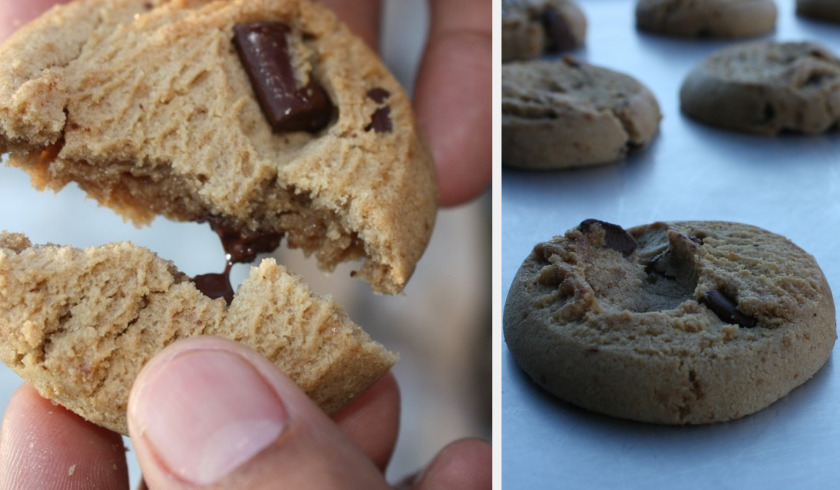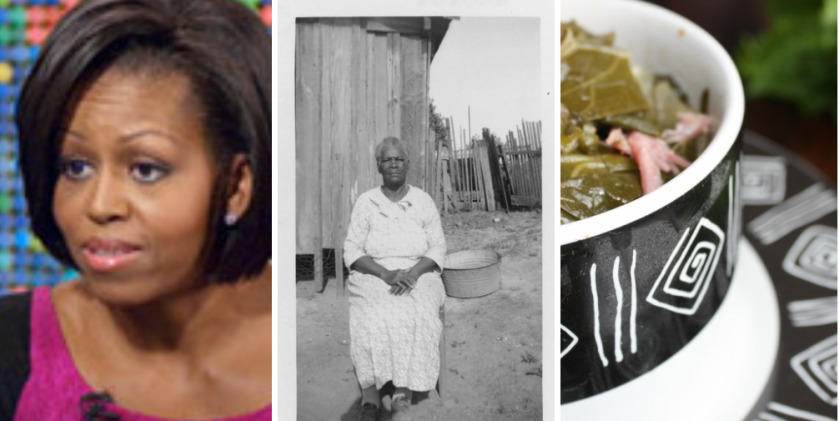
by Toni Tipton-Martin | Feb 17, 2010 | Plantation Cooks
A month into my study of black women cooking in America’s kitchens and already I can see numerous professional characteristics displayed by slave women. Plantation cooks worked under pressure and still devoted attention to detail. Fashioned a creative style under stone-age conditions from meager ingredients. Possessed exceptional organizational skills.
But, it was their forebearing management style that caught my attention this week, following popular British chef Jaime Oliver’s TED challenge that Americans take back responsibility for educating their children about food. If Oliver’s plans to join the Obamas and others in the fight against obesity and food ignorance seems intrusive, it shouldn’t; we live in an era when many adults become completely depressed by the thought of kids in the kitchen.
Not these women. They supervised a gaggle of helpers, some of them young children, without surrendering their hearts to despair just because of the distraction and hazard of children underfoot.
We all know that slavery’s children were exposed to heavy labor at an early age. From Works Progress Administration interviews, we also learn about the skills and traditions their mothers handed down to them as they worked side by side, which reveals a communal spirit, not weakness.
Imagine Mammy or Aunt Chloe redirecting her feelings, telling herself and her children they were allowed “to “play” in her kitchen or to “help out” with the cooking. At the same time, in an informal way, she taught them basic responsibilities, transferred culinary expertise, and instilled confidence and self-esteem, when she allowed the child to accomplish simple tasks like helping her to put on a pot of rice.
Aunt Mary Graham remembered that Mammy Rose, the cook managed the fireplace and several servants at once, including children on her Washington, Louisiana plantation. Aunt Mary was the “table gal,” who learned from the Missus how to “make it fitten fo’ fine folks ter eat at.”
A small girl, usually the cook’s daughter, carried the food to a small table near the kitchen door, then the table gal would carry the meal into the dining room. Mammy Rose, she said, “Didn ‘low no boys ter wait on tables caise dy rush roun’ so fas’ an’ spill things.”
Mandy Morrow, a former Texas slave who cooked in the Governor’s Mansion, was one also of those early trainees. She recalled carrying food pails to the field, managing the smoke in the smokehouse, making preserves, and “making sorghum molasses every year to sweeten the coffee.”
Aunt Charity Anderson, one of six house servants, explains: “My job was lookin’atter de corner table whar nothin’but de desserts set.”
I have to admit that some nights, these narratives troubled my sleep, but most times, I tried to put on my own mother apron and think about the joy I share with my children at the table. And that brought memories of my son Brandon’s Chocolate Chip Cookies to mind. His recipe is a family favorite that grew out of a challenge when he was in middle school and I was a newspaper food editor. He taunted me into a weekend cookie bake-off, which he proceeded to win with this simple, sweet recipe. I make them with the kids in my cooking classes and we still laugh about it today.
What recipe did your mother use to bring you into the kitchen?
In Her Kitchen
Chocolate Chip Cookies
Ingredients
- ½ cup margarine
- ½ cup shortening
- ¾ cup brown sugar, firmly packed
- ½ cup sugar
- 1 ½ teaspoons vanilla
- 1 egg
- 1 ¾ cup all-purpose flour
- 1 teaspoon baking soda
- ½ teaspoon salt
- 1 cup semi-sweet chocolate chips
Instructions
- Preheat oven to 350 degrees. In a large bowl, stir together margarine and shortening until mixed and light yellow. Add sugars and stir until creamy. Stir in vanilla and egg. Stir in flour, soda and salt. Blend well. Stir in chocolate chips and mix well. Wrap in plastic and shape into a 12-inch log. Refrigerate until firm. Slice cookies about ¼-inch thick or drop dough by rounded teaspoonfuls, 2 inches apart onto a lightly greased cookie sheet (or spray with non-stick vegetable spray). Bake for 8 to 10 minutes or until light golden brown. Immediately remove cookies from cookie sheet to wire racks and cool.
Number of servings: 48
In Her Kitchen

by Toni Tipton-Martin | Feb 10, 2010 | Plantation Cooks
Yesterday, the First Lady announced an ambitious initiative designed to “eliminate childhood obesity in a generation.” Her nationwide campaign, entitled “Let’s Move,” was kicked off with a presidential memorandum that established a plan to evaluate and coordinate public and private services, and to improve health information so that parents can make better decisions about their children’s diets.
In a news conference announcing a multi-agency task force, Michelle Obama explained that our children aren’t responsible for the epidemic that confronts this country — 1 in 3 children is considered obese, while this country spends $150 billion each year treating obesity-related illnesses. Michelle also explained to reporters that the idea for the program came to her as a response to advice from Sasha and Malia’s pediatrician, who suggested that she “…might want to do things a little bit differently.” After all, Michelle Obama reminded viewers, it is parents who are responsible for making healthier food choices available and appealing to youngsters, and who can and should encourage kids to spend less screen time, and more time engaged in physical activity — preferably outdoors.
I wasn’t surprised at all by the First Lady’s commonsense approach to today’s confusing health messages, food labeling chaos and the dearth of wholesome, fresh food in some urban communities — what she called, “food deserts.” Michelle descends from a legacy of women who made survival in difficult times an art form.
We are all busy. Food portions are huge. Chemicals and artificial ingredients are hidden from view. And, yes, sugar is everywhere. But that does not mean we have to live as victims. With inspiration from our foremothers, we can choose dietary balance and moderation without resorting to packaged, artificial foods for convenience.
Just consider the focus, and imagination of slave cooks, unable to read or write, as they performed multiple tasks at one time, and demonstrated remarkable feats of recall, memorizing dozens of English recipes as they prepared meals in Big House and cabin kitchens. In a patriarchal system that didn’t even offer slave women control over their own sexuality, choosing a particular food, and a particular means of preparation, contributed to their sense of self-esteem because it offered them a small element of control. These women managed to maintain vestiges of their African cultural past while preparing meals for the master’s family and their own without the constant eye of the “missus” looking over their shoulders.
We can live with minimal exposure to the world’s apple, too.
The traditional view of a slavewoman’s responsibility for preparing and serving meals in her master’s hot cookshop mirrored her image as a lowly servant charged with the most onerous and arduous tasks of the household. But, the role of food and cooking took on immense cultural and ideological significance when she returned to the privacy of her home in the slave community.
Lizzie Farmer of McAlester, Oklahoma, remembers family cooking with some fondness; it was a time for women “to spend the day together,” trying out new skills and preparing fresh, seasonal foods:
“Young mistress taught me how to knit, spin, weave, crochet, sew and embroider,” Farmer told an interviewer for the Works Progress Administration. “In the cullud quarters, we cooked on a fireplace in big iron pots. Our bread was baked in iron skillets with lids and we would set the skillet on de fire and put coals of fire on de lid. When we want to cook our vegetables we would put a big piece of hog jowl in de pot. We’d put in a lot of snap beans and when dey was about half done we’d put in a mess of cabbage and when it was about half done we’d put in some squash and when it was about half done we’d put in some okra. Then when it was done we would take it out a layer at a time.”
Like French chefs who recalled their “old ways” when dealing with unfamiliar foodstuffs and working with “inferior substitutes” following wartime, slave cooks, applied “African grammar – methods of cooking and spicing from remembered recipes, and ancestral tastes to the grains, fruits, vegetables, meats of the New World,” says historian Charles Joyner. They demonstrated technical knowledge and skill, took their time, and followed directions with discipline and order.
Food rations varied little from plantation to plantation – cornmeal, pork fat, molasses, and sometimes coffee, depending upon the master, making food collecting a necessity slave women turned into a luxury to maintain cultural continuity with Africa. All across the south, black cooks enlivened the family’s monotonous diet, before and after their work day by hunting, fishing, crabbing, oystering, clamming, foraging for wild nuts, fruit and vegetables, and gardening in small plots.
They evaluated the quality of ingredients at their disposal and determined their flavor profiles. They considered how one food might work with another according to taste, aroma, and appearance. They understood the importance of food safety and maintaining freshness, and identified the proper way to store and hold various ingredients. And, they relied upon rudimentary tools such as mortars and pestles to pound out “sarakas” flat rice cakes.
Mom Hester Hunter, of South Carolina, explains that cooks balanced work and home with advance preparation and organization. In her WPA interview, she said: “De peoples sho cook dey dinner for Sunday on Saturday in dat day en time.”
Slave women also applied classic techniques (like those taught in today’s culinary academies) to common ingredients. They supplemented meager stocks and broths with fresh meat scraps. They braised meat bones and aromatic vegetables into stews; roasted wild game; stewed wild leaves and greens; thickened meal into mush; preserved seasonal fruits into jelly, substituted sweet potatoes for rice, cured ham. They coped with the differences between “tenderness and putrefaction;” understood timing, frying, poaching, sautéing, galantines, fermentation, custards, and forcemeats.
Michelle Obama’s new initiative doesn’t tell us exactly how to improve our health and slow the pace toward obesity, but even casual observers can see some clues in our ancestry: Simple, fresh ingredients. Plucked from the garden. Made from scratch. Following standard techniques. Spiced with cultural seasonings. Portion control.
What were some of your mother’s food rules? “Clean your plate; eat your vegetables?” Click Comments below to share them with us.
In Her Kitchen
Collard Greens and Turkey
Ingredients
- 3 ½ quarts water
- 1 smoked turkey leg
- 1 onion, chopped, about 1 cup
- 3 garlic cloves, minced
- 2 pounds (2 bunches) collard greens, chopped
- Salt, pepper
Instructions
- Bring water, turkey, onion and garlic to boil in a large kettle, then reduce the heat and simmer 20 minutes. Meanwhile prepare the greens. Cut off and discard about 4 inches of the stem. Stack 5 or 6 leaves, roll up, and slice greens into 1-inch strips. Roughly chop, chopping stems more than the green tops. Add greens to the turkey broth, cover, and cook over medium heat about 2 hours. Season to taste with salt and pepper.
Number of servings: 8
In Her Kitchen




Comments